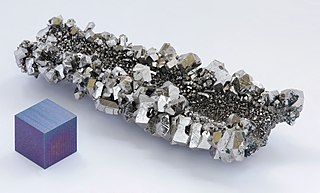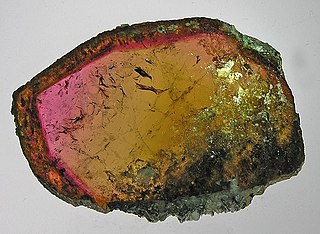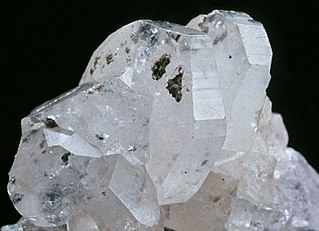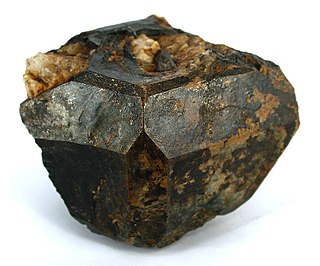
Niobium is a chemical element; it has symbol Nb and atomic number 41. It is a light grey, crystalline, and ductile transition metal. Pure niobium has a Mohs hardness rating similar to pure titanium, and it has similar ductility to iron. Niobium oxidizes in Earth's atmosphere very slowly, hence its application in jewelry as a hypoallergenic alternative to nickel. Niobium is often found in the minerals pyrochlore and columbite, hence the former name "columbium". Its name comes from Greek mythology: Niobe, daughter of Tantalus, the namesake of tantalum. The name reflects the great similarity between the two elements in their physical and chemical properties, which makes them difficult to distinguish.

Topaz is a silicate mineral made of aluminum and fluorine with the chemical formula Al2SiO4(F, OH)2. It is used as a gemstone in jewelry and other adornments. Common topaz in its natural state is colorless, though trace element impurities can make it pale blue or golden brown to yellow-orange. Topaz is often treated with heat or radiation to make it a deep blue, reddish-orange, pale green, pink, or purple.

Tourmaline is a crystalline silicate mineral group in which boron is compounded with elements such as aluminium, iron, magnesium, sodium, lithium, or potassium. This gemstone comes in a wide variety of colors.

A pegmatite is an igneous rock showing a very coarse texture, with large interlocking crystals usually greater in size than 1 cm (0.4 in) and sometimes greater than 1 meter (3 ft). Most pegmatites are composed of quartz, feldspar, and mica, having a similar silicic composition to granite. However, rarer intermediate composition and mafic pegmatites are known.

Columbite, also called niobite, niobite-tantalite and columbate, with a general chemical formula of (FeII,MnII)Nb2O6, is a black mineral group that is an ore of niobium. It has a submetallic luster, a high density, and is a niobate of iron and manganese. Niobite has many applications in areospace, construction and the medical industry. Dating columbite minerals is primarily completed by uranium lead (U-Pb) dating, a slow process.
A period 5 element is one of the chemical elements in the fifth row of the periodic table of the chemical elements. The periodic table is laid out in rows to illustrate recurring (periodic) trends in the chemical behaviour of the elements as their atomic number increases: a new row is begun when chemical behaviour begins to repeat, meaning that elements with similar behaviour fall into the same vertical columns. The fifth period contains 18 elements, beginning with rubidium and ending with xenon. As a rule, period 5 elements fill their 5s shells first, then their 4d, and 5p shells, in that order; however, there are exceptions, such as rhodium.

Euxenite, or euxenite-(Y), is a brownish black mineral with a metallic luster.

Phenakite or phenacite is a fairly rare nesosilicate mineral consisting of beryllium orthosilicate, Be2SiO4. Occasionally used as a gemstone, phenakite occurs as isolated crystals, which are rhombohedral with parallel-faced hemihedrism, and are either lenticular or prismatic in habit: the lenticular habit is determined by the development of faces of several obtuse rhombohedra and the absence of prism faces. There is no cleavage, and the fracture is conchoidal. The Mohs hardness is high, being 7.5–8; the specific gravity is 2.96. The crystals are sometimes perfectly colorless and transparent, but more often they are greyish or yellowish and only translucent; occasionally they are pale rose-red. In general appearance the mineral is not unlike quartz, for which indeed it has been mistaken. Its name comes from Ancient Greek: φέναξ, romanized: phénax, meaning "deceiver" due to its close visual similarity to quartz, named by Nils Gustaf Nordenskiöld in 1833.

The mineral group tantalite [(Fe, Mn)Ta2O6] is the primary source of the chemical element tantalum, a corrosion (heat and acid) resistant metal. It is chemically similar to columbite, and the two are often grouped together as a semi-singular mineral called coltan or "columbite-tantalite" in many mineral guides. However, tantalite has a much greater specific gravity than columbite (8.0+ compared to columbite's 5.2). Iron-rich tantalite is the mineral tantalite-(Fe) or ferrotantalite and manganese-rich is tantalite-(Mn) or manganotantalite.
Tantite is a rare tantalum oxide mineral with formula: Ta2O5. Tantite forms transparent microscopic colorless triclinic - pedial crystals with an adamantine luster. It has a Mohs hardness of 7 and a high specific gravity of 8.45. Chemical analyses show minor inclusion (1.3%) of niobium oxide.
Miarolitic cavities are typically crystal-lined irregular cavities or vugs most commonly found in granitic pegmatites, and also in a variety of igneous rocks. The central portions of pegmatites are often miarolitic as the pegmatite dike crystallizes from the outside walls toward the center. The volatile portion of the magma is gradually excluded from the forming crystal phases until it becomes trapped within the body and forms the cavities which often contain minerals of elements incompatible with the typical silicate granitic mineralogy.

Microlite was once known as a pale-yellow, reddish-brown, or black isometric mineral composed of sodium calcium tantalum oxide with a small amount of fluorine. Its chemical formula is (Na,Ca)2Ta2O6(O,OH,F). Today it is a name of a group of oxide minerals of a similar stoichiometry having tantalum prevailing over titanium and niobium. The microlite group belongs to a large pyrochlore supergroup that occurs in pegmatites and constitutes an ore of tantalum. It has a Mohs hardness of 5.5 and a variable specific gravity of 4.2 to 6.4. It occurs as disseminated microscopic subtranslucent to opaque octahedral crystals with a refractive index of 2.0 to 2.2. Microlite is also called djalmaite, but both names are now obsolete.

Jeremejevite is an aluminium borate mineral with variable fluoride and hydroxide ions. Its chemical formula is Al6B5O15(F,OH)3. It is considered as one of the rarest, thus one of the most expensive stones. For nearly a century, it was considered as one of the rarest gemstones in the world.

Tanco Mine or Bernic Lake mine is an underground caesium and tantalum mine, owned and since 2019 owned and operated by Sinomine Resource Group on the north west shore of Bernic Lake, Manitoba, Canada. The mine has the largest known deposit of pollucite and is also the world's largest producer of caesium.

Ixiolite is an accessory oxide mineral found in granitic pegmatites. It is an oxide with the general chemical formula (Ta,Nb,Sn,Mn,Fe)4O8 or (Ta,Mn,Nb)O2.
The Three Aloes mine is a large mine located in the western part of Namibia in Erongo Region. Three Aloes represents one of the largest tantalum reserves in Namibia, having estimated reserves of 13.2 million tonnes of ore grading 0.026% tantalum.

Béhierite is a very rare mineral, a natural tantalum borate of the formula (Ta,Nb)BO4. Béhierite is also one of the most simple tantalum minerals. It contains simple tetrahedral borate anions, instead of more common among minerals, planar BO3 groups. It forms a solid solution with its niobium-analogue, schiavinatoite. Both have zircon-type structure (tetragonal, space group I41/amd) and are found in pegmatites. Béhierite and holtite are minerals with essential tantalum and boron.
Nioboholtite is an extremely rare mineral with the formula (Nb0.6[]0.4)Al6BSi3O18. It is the niobium-rich member of the dumortierite supergroup, and the niobium analogue of holtite of the holtite group. It is one of three quite recently found minerals of this group, the other two being titanoholtite and szklaryite, all coming from the Szklary village near Ząbkowice Śląskie in Poland. They occur in a unique pegmatite. Nioboholtite and schiavinatoite are both minerals with essential niobium and boron.

The Harding Pegmatite Mine is a former adit mine that extracted lithium, tantalum, and beryllium from a Precambrian pegmatite sill. It ceased operations in 1958 and its owner, Arthur Montgomery, donated it to the University of New Mexico, which runs the site as an outdoor geology laboratory with mineral collecting permitted on a small scale.

Aquamarine is a pale-blue to light-green variety of the beryl family, with its name relating to water and sea. The color of aquamarine can be changed by heat, with a goal to enhance its physical appearance. It is the birth stone of March.















